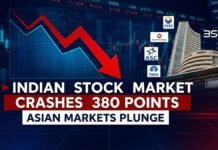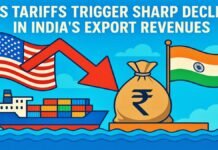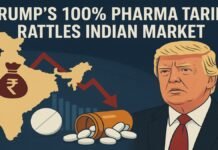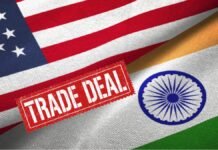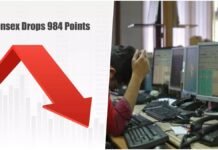
Key Points
- US President Donald Trump imposed a 25% tariff on Indian imports from August 1, 2025, after trade talks failed to meet the deadline.
- An extra penalty is expected due to India’s ongoing trade relations with Russia.
- Indian stock market plunged, with Sensex opening down 786 points and Nifty falling by over 200 points; textile stocks witnessed up to 9% losses.
- US is India’s top textile export market; textile/apparel exports to the US rose 13% to $4.59 billion (Jan–May 2025).
- Tariff will squeeze profits for major exporters, threaten jobs, and reduce orders; many companies pivoting to Europe and Middle East for new business.
- US tariffs on India are lower than China’s (up to 55%) and Bangladesh’s (35%), but higher than Vietnam’s (20%) and Indonesia’s (19%).
- Market volatility expected as trade talks may continue into fall; export industry braces for tougher months ahead.
New Delhi: In a high-stakes setback for India-US economic ties, President Donald Trump on July 30, 2025, announced a sweeping 25% tariff on Indian goods effective August 1, after both sides missed the deadline to reach a new trade agreement. The US also signaled additional penalties for India’s continued business with Russia, particularly in energy and defense.
Stock Market in Turmoil
Indian financial markets reacted strongly to the announcement. The Sensex opened down by over 786 points, while the Nifty slipped more than 212 points at the start of Thursday trading. Key export-driven sectors bore the brunt, with shares of major textile companies such as Gokaldas Exports, Welspun Living, Arvind, and Vardhman Textiles tumbling 3–9% in early BSE trade. Gems, jewelry, electronics, and pharmaceuticals also reported heavy selling pressure.
Textile Sector Faces Major Blow
The US remains India’s largest single market for textile and apparel exports. From January to May 2025, Indian exports in this sector to the US surged to $4.59 billion a 13% year-on-year rise. Analysts now warn that the new tariff could sharply curtail this progress, slashing profitability and orders for Indian exporters.
According to the Confederation of Indian Textile Industry, “the higher tariffs will erase much of the competitive edge India had hoped to gain over rivals like Vietnam.” Industry leaders expect a significant profitability squeeze that may force companies to accelerate their push into European, British, and Middle Eastern markets.
How US Tariffs Compare Globally
India’s new 25% tariff is higher than those for several other US trading partners Vietnam faces 20%, Indonesia 19% but still lower than China’s (up to 55%) and Bangladesh’s (35%). The pressure is compounded by a lack of clarity on the size of the penalty for India’s Russian dealings, which is keeping exporters and investors on high alert.
| Country | US Tariff Rate (2025) |
|---|---|
| India | 25% |
| China | Up to 55% |
| Bangladesh | 35% |
| Vietnam | 20% |
| Indonesia | 19% |
| Cambodia | 36% |
Industry & Expert Reactions
- Market strategists say up to 10% of India’s US-bound exports are at immediate risk. Stocks are likely to remain volatile in coming weeks until clarity on negotiations and penalties emerges.
- Exporters are bracing for reduced US orders, with calls for government support and proactive outreach to new markets.
- Government officials maintain that trade talks are ongoing, and there is hope of a deal by fall 2025, but warn of “serious consequences” if tariffs persist.
Looking Ahead
If the trade standoff continues, Indian companies may be forced to cut jobs, delay investments, and shift their export focus. Market turmoil could persist India’s benchmark market is already down $248 billion from all-time highs this month. Meanwhile, businesses and consumers in both countries may face higher prices and decreased product choice as new tariffs ripple through supply chains.
The India-US trade relationship is now at a crossroads, with the outcome set to reshape not only economic ties, but also the strategic calculus of two major global players.
































